BLOOD PHONES, By William Thomas
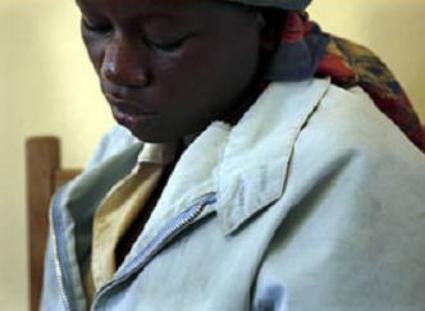
The next time your cell phone rings and you bring it up to your ear, listen closely. You may be able to hear the muted echoing screams of women and girls being raped by greed-crazed, frightened men intent on obtaining a tiny piece of mineral used in your phone. It’s called coltan. And the frenzied rush for its extraction in strip mines across the Congo is exploiting children, razing pristine forests, endangering rare mountain gorillas – and has already led to the rape and horrific mutilation of more than 250,000 women as old as 75 and girls as young as three. I could not bring myself to show the picture of a “soldiers’ hacking off the severed stump of a raped, naked woman with his knife.
Short for columbine tantalite, coltan is in huge and gowing demand by high technology industries rushing to meet a consumer frenzy for brain numbing, irradaiting gadets. Its high melting point and resistance to corrosion coupled with its unique ability to conduct heat and electricity make coltan particularly prized in cell phones, as well as wireless laptop computers, TVs and other consumer “bads” marketed and sold as “goods”. Coltan is mainly extracted from chopped down Congo forests, where strip-mining is carried out by workers, many of them children. More than 10,000 people have abandoned their farms and urban centers and moved into the Kahuzi-Biega National Park to cut down the pristine forest, home of endangered gorillas, and mine coltan under the direction of rebels, who continue raping women as “needed”. [IUCN Apr 23/01; Global Witness 2004; World Rainforest Movement Nov 14/05; assets.panda.org; PRNewswire]
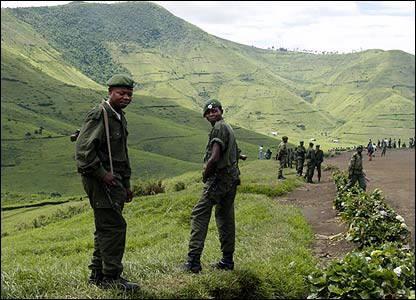
THE GREATEST SILENCE
Michael Winship met Lisa Jackson while working in television in Washington, DC. Showing on HBO, Jackson’s latest TV documentary - "The Greatest Silence: Rape in the Congo" – exposes what Winship terms, “the unimaginable human tragedy in the third largest nation on the African continent.
“As under-reported as the horrific genocide in Darfur, Somalia, has been, it's front-page, headline news compared to the untold, unbearable and far vaster suffering of the Democratic Republic of Congo. Civil war began there in 1997 and has never really ceased. Further fueled by neighboring rebels from Uganda, Burundi and Rwanda, this is the deadliest conflict since World War II, with four million killed in a decade of fighting and an estimated more than 250,000 women and children raped.”
The rebels aren't the only ones guilty of mass rape, Winship points out. “Members of Congo's own military are culpable, too, and even some of Winser's 17,000-member United Nations peacekeeping force have been accused of trading milk and eggs for sex with girls as young as ten.”
Because Lisa Jackson had been gang-raped by three men one night in Washington's fashionable Georgetown, she was able to win the trust of traumatized rape victims in the Congo.
“They asked about the war that was happening in my country. I told them there had been no war in Washington, DC, back then, that any woman could become a victim at any time," Jackson relates.
What these women tell her camera is "soul-ripping," Lisa Jackson says. One woman, describing the three years she spent as a sex slave, says, "When we were living in the forest it wasn't just one man. Every soldier can have sex with you. We got pregnant there. We gave birth in the forest, alone, like animals, without food or medicine."
Her story is far from the worst told in "The Greatest Silence."
The Congo remains rich in gold, silver, diamonds, oil, uranium, Winship lists. But that’s not all. Fully 80% of the world's supply of coltan – a mineral essential for the manufacture of capacitors used in most consumer electronics, particularly cell phones and wireless laptop computers – is also being raped from the living earth of the Congo, where smugglers steal one million dollars worth of coltan every day.
Addressing the Senate Judiciary and Foreign Relations Committees after screening "The Greatest Silence," and then testifying before the Senate Subcommittee on Human Rights and the Law, Lisa Jackson told the U.S. legislators that, because of the coltan trade, "the blood of Congolese women is on your laptops and in your cellphones."
Maj. Honorine Munyole of the National Police is a one-woman Special Victims Unit investigating sex crimes. As she puts it, "The woman is the mother of a nation. He who rapes a woman rapes an entire nation." [truthout Apr 1/08]
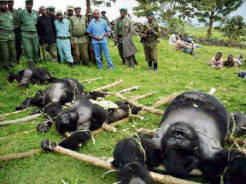
A second television documentary – this one British – has also exposed how the precious mineral Coltan, essential to mobile phone technology, is driving Africa’s great apes to the brink of extinction. "No Hiding Place - Part Two" of the BBC’s “Earth Report” series shows how coltan raped from the Earth in huge “strip” mines by
According to ENS, “The mineral, which is the linchpin of multi-billion dollar corporate cell phone profits, is obtained almost exclusively from the Democratic Republic of Congo, where this eastern lowland gorilla is completely dependent on intact forests.”
Now in steep decline, eastern lowland gorilla populations need all the help they can get. In just the last five years of the cell phone boom, these eastern lowland gorillas have declined by 80% to 90% – with just 3,000 or so animals left alive on this planet.
Renowned for her 40 years of work with chimpanzees, primatologist Dr. Jane Goodall has told TVE producers that the problem has become even more serious as big logging companies - especially European clear-cutters - have opened up the forests to bushmeat hunters who kill wild animals, not for subsistence but for sale to urban customers.
"Hunters from the towns go along the roads and shoot everything - elephants, apes, monkeys, bats and birds," Goodall said. "They smoke it, load it on to the trucks and take it into the cities. It doesn't feed starving people, but people who'll pay more for bushmeat. Goodall noted that after living in harmony with the forest for centuries, pygmy hunters are being given guns and ammo and paid to shoot wild animals to feed the logging camps destroying their homes and way of life.
"The animals have gone, the forest is silent, and when the loggers finally move what's left for the indigenous people? Nothing," Goodall said.
After being hit by the deadly Ebola virus and the destruction of the mountain forests in the relentless hunt for “bush meat” and coltan to sell to upscale Western markets – the world’s last 700 mountain gorillas live where Rwanda, the Democratic Republic of Congo and Uganda meet.
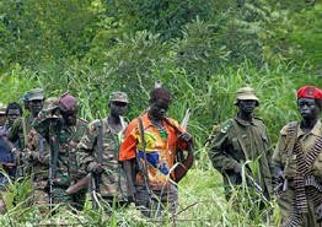
Now that the three countries are coming together to protect the great apes, there is some hope for the gorillas. But the smugglers, rebels, loggers, UN personnel and other gangs continue to roam the Congo. The fate of Congolese women and girls caught in the frenzy to supply coltan to Western cellphone manufacturers is as yet unknown.
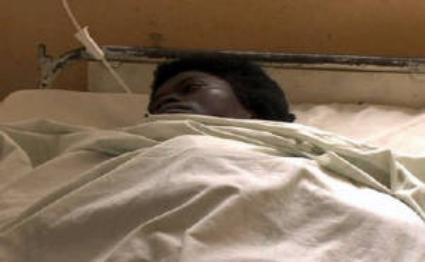
DIAL “R”
Dial “c” for clearing Congolese rainforest.
Dial “g” for gorilla.
Dial ‘s’ for strip mining.
Dial “r” for rape.
“Women are dying two types of death,” says Christine Karumba, Country Director, Women for Women International in the “Democratic” Republic of Congo. “The two types of death are the physical and the emotional death. The physical death is where you are no longer alive to walk the earth, and the emotional death is where you no longer see signs of hope and are dead inside.”
“We had so many difficulties in this war,” relates Yvette, 15. “The military pillaged our house and they killed my aunt in May 2004. I was studying in fourth year of primary school when a government soldier raped me. He took me on the road by force when I left school. He was the first man that I knew and he raped me. Then he carried me to his military camp and he left me there like his wife.” [BBC News 24]
During the coltan shortage between late 1999 and early 2001, when supply was falling behind the world’s voracious demand for cell phones, a kilo of coltan fetched $200 at a time when the Rwandan mercenary army was exporting at least 100 tons – or $20 million – per month. Experts and dealers estimate that Rwandan mercenaries made at least $250 million over a period of 18 months – enough to protect the companies extracting the coltan and finance a war that has so far filled more than six million people.
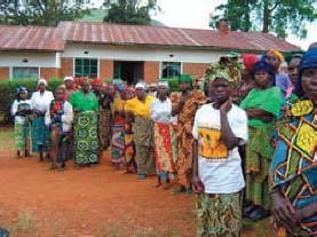
“Governments won’t do anything” – above taxes from the companies and their employees – Whitehall “made £3 billion from the mobile phone companies from the sale of the 3G licenses” last year. “And you only need to sit on a London bus for five minutes to see how important mobiles have become to people’s psychosocial identities.”
A UN report cites “something like $200-250 million” worth
of coltan going out through Goma every month. Another source puts
current coltan sales at $18-20 million a day in a region known for rape,
bloodshed and poverty.
While some coltan is mined in
Australia, Brazil and Canada, there is a 4 in 5 chance that any mobile
phone is a ‘blood mobile’. According to Ethical Consumer, there is not a
single mobile company revealing its coltan sources – “so presumably
they all use DRC Coltan,” as one blogger named Jonathan puts it.
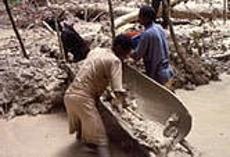
In June 2001, among the postings about Dutch work visas and Italian pen pals on an Internet bulletin board called the Embassy Network, came this blunt proposal: "How much do you want to offer per kilogram? Please find me at least 100,000 U.S. dollars and I will deliver immediately."
“The substance for sale wasn't cocaine or top-grade opium,” wrote Kristi Essick in her landmark 2001 trade publication article, “Guns, Money and Cell Phones”. It was coltan - one of the world's most sought-after materials.
“Refine coltan and you get a highly heat-resistant metal powder called tantalum. It sells for $100 a pound, and it's becoming increasingly vital to modern life. For the high-tech industry, tantalum is magic dust, a key component in everything from mobile phones made by Nokia (NOK) and Ericsson and computer chips from Intel (INTC) to Sony (SNE) stereos and VCRs.”
According to Essick, “Most of the worldwide tantalum supply – valued at as much as $6 billion a year – comes from legitimate mining operations in Australia, Canada and Brazil.”
But as demand for tantalum has taken off with today’s boom in high-tech products, “a new, more sinister market began flourishing in the Democratic Republic of Congo. There, warring rebel groups – many funded and supplied by neighboring Rwanda and Uganda – are exploiting coltan” to help finance a bloody civil war.
"There is a direct link between human rights abuses” – including a more than a quarter million rapes – “and the exploitation of resources in areas in the DRC occupied by Rwanda and Uganda," says Suliman Baldo, a senior researcher in the Africa division at Human Rights Watch, a New York-based nongovernmental organization that tracks human-rights abuses worldwide.
Since June 1999, “rebels have driven farmers off their coltan-rich land and attacked villages in a civil war raging, in part, over control of strategic mining areas.,” Essick reported The Ugandan and Rwandan rebels "are just helping themselves," Baldo says – to women and young girls, as well as coltan. Gorillas are also being massacred and driven out of the coltan-rich areas.
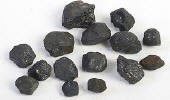
HOOKED ON COLTAN
Essick recalls how a similar controversy “wracked the diamond industry in the late 1990s, when global demand for the gems helped finance civil wars in Sierra Leone, Angola and Liberia. Since then, the international community has clamped down on the diamond trade, imposing tougher import and exportThe UN report documents the rebel militia using “forced labor, illegal monopolies and civilian murder in their high-stakes game to extract this valuable resource.”
Leonard She Okitundu, Congo minister for foreign affairs and international cooperation, told the United Nations Security Council in early May 2001 of "links between the shameless looting of Congolese natural wealth and the massacres of the Congolese people." The fighting, he reported, had led to "assassinations of civilians, deportations, torture, rape and deliberate spreading of HIV/AIDS" – as well as the displacement of millions of refugees.
Ericsson, Intel, Nokia and other major cell phone companies deny any knowledge of where their coltan comes from. Which must make ordering and inventory keeping extremely difficult. In 2001, about 15% of the world's supply of tantalum (coltan) came from Africa, and about 70% from Australia. But the Congo is tied with Canada in having the world's fourth-largest coltan reserve, and by 2008 its share of the cell phone coltan market has grown substantially.
“Coltan is found in 3 billion-year-old soils, like those in the Rift Valley region of middle Africa, western Australia and central Asia. The tantalum extracted from the ore makes capacitors – tiny components that manage the flow of current in electronic devices. Many semiconductors (computer chips found in nearly every modern weapon and appliance) also use a thin layer of tantalum as a protective barrier between other metal coatings. Coltan is also used in the airline, chemical, pharmaceutical and automotive industries,” writes Kristi Essick.
But cell phone makers are among the heaviest users of coltan.
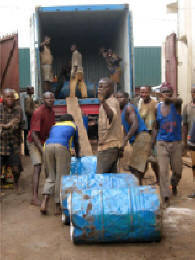
As many as three in ten schoolchildren in the northeastern Congo have left school to dig for coltan. Miners work for a few dollars a day while extracting the valuable ore, and are often cheated out of their wages. "Mining coltan is in itself a terrible job," one miner said. "But there is also the problem of armed bandits who steal our goods, as well as the danger of landslides and collapsing mines."
Coltan convoys run by one rebel group are often hijacked by rival rebels and resold to other traders. More than 20 international mineral trading companies import minerals coltan from the Congo via Rwanda for cell phone users in Asia, Europe and the United States. Sabena Airlines, Belgium's national carrier, regularly flies coltan and other minerals out of the Congo, Uganda and Rwanda. American Airlines transships these suspect minerals throughout the United States.
Refined tantalum powder ends up at capacitor manufacturers, including AVX Epcos, Hitachi, Kemet, NEC and Vishay. Products containing “blood minerals” end up in laptops, cell phones and other consumer products sold by Alcatel, Compaq, Dell, Ericsson, Hewlett-Packard, IBM, Lucent, Motorola, Nokia and Solectron. AMD and Intel are also buying tantalum powder to make computer chips, Essick has found.
"We first heard about this in April (2001) and immediately asked our suppliers if they used tantalum from the Congo," said Outi Mikkonen, communications manager for environmental affairs at Nokia. "All you can do is ask, and if they say no, we believe it."
Marketers are not going to admit, “Yes, the tantalum-coltan we’re selling you comes covered in rapes and bloodshed.”
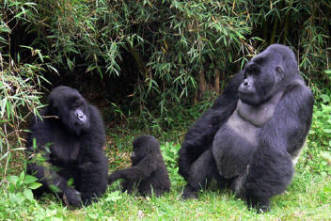
“Tantalum suppliers can offer little assurance to capacitor manufacturers that their product doesn't come courtesy of the Congo rebels,” Essik notes. "I'm not in favor of killing gorillas," says Dick Rosen, CEO of AVX, a tantalum capacitor maker in Myrtle Beach, South Caroline. "We don't have an idea where it comes from. There's no way to tell. I don't know how to control it."
Simple. Stop buying it.
The corporate wall of deniability is fraught with fissures. While H.C. Starck is adamant it is not being supplied with black-market coltan, one of its suppliers, the U.K.-based trading company A&M Minerals and Metals buys up to three tons of tantalum-bearing ore every month from Uganda. "I couldn't tell you for 100 percent that this material [from Uganda] didn't come from the Congo," says managing director James McCombie. "It could have been smuggled across the border. It is very difficult to check the provenance. It would be silly of us to try to pretend that we know the origin of every pound of [coltan] we get in our hands."
Brussels-based Sogem, another international trading company selling unrefined coltan from the Congo and Rwanda to processing companies in the United States, Europe and Asia, is vague on how much misery its minerals contain. Sogem After declining to name the mines and local trading companies that supply Sogem, spokeswoman Moniek Delvou admits she isn't 100% sure of the original source.
Compaq says it "condemns the reported activities of illegal miners in the Kahuzi-Biega National Park and the Okapi Wildlife Reserve in the Democratic Republic of Congo." But spokesman Arch Currid says, "Most of the components that we get [come] from third-party providers, so where they get their raw goods is hard to determine."
Motorola and Hewlett-Packard also denounce the destruction of wildlife, the forest habitat and women’s health, sanctity and futures. But they keep buy coltan from the Congo.
The U.N. is calling for an complete trade embargo on the import and export of coltan and other minerals from or to Burundi, Rwanda and Uganda "until those countries' involvement in the exploitation of the natural resources of the Democratic Republic of the Congo is made clear and declared so by the Security Council.”
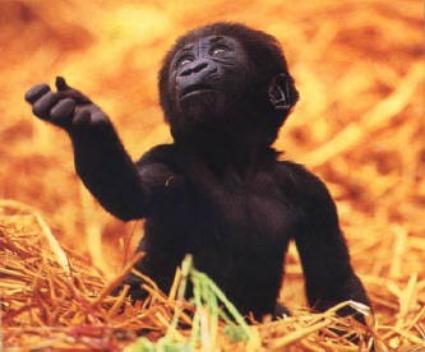
A BAN ON CONGO COLTAN?
Given the problems policing the coltan trade, Baldo of Human Rights Watch believes only an embargo will begin to reverse the tide of abuse in the Congo. "I would encourage the U.N. Security Council to adopt an embargo against Rwanda and Uganda, because they rely on international assistance," says Baldo. Sanctions imposed by foreign governments could thus have an immediate effect in the region. Rwandan and Ugandan rebels "are exploiting resources illegally and know sooner or later this will become unacceptable," Baldo adds.
The difficulty is to come up with sanctions on minerals like coltan that don't have a further negative impact on the people of the region.
Alcatel says it would abide by a UN resolution blocking coltan exports from the Congo. Ericsson would keep importing it, despite any ban. [Industry Standard Magazine June 11/ 01]
Seven years later – with global consumers continuing to crave the newest cell phone and the latest whizbang computers, and high-tech companies continuing to pay big dollars for tantalum capacitors, and their suppliers supplying tantalum from wherever they can get – the UN Security Council has yet to act, despite a UN panel is calling for a moratorium on all exports of gold, timber, diamonds, cobalt, copper - and coltan.
And women, young girls and gorillas with whom we share most of our genes continue to pay the price.

As a cell phone and laptop user, there is no point in feeling guilt for something we were never told by a corporate media that continues to censor stories damaging to their big cell phone and computer advertisers.
But now that we know, we are bound by human decency and conscience to act. Since guidelines guaranteeing the providence of cell phone and wireless laptop coltan do not yet exist, we cannot in good conscience purchase any more of these new devices.
So please – DO NOT BUY A CELL PHONE, OR WIRELESS LAPTOP COMPUTER – that is not specifically and independently certified to contain coltans extracted in Australia, Canada or Britain under Fair and Humane Trade guidelines.
Since no such guidelines exist, only a worldwide consumer boycott will motivate manufacturers to do the right thing. Right now, you will be doing the women of the Congo, the great apes, yourself and your children an immense favor by not buying a cell phone. The life and dignity you save will not just be your own.
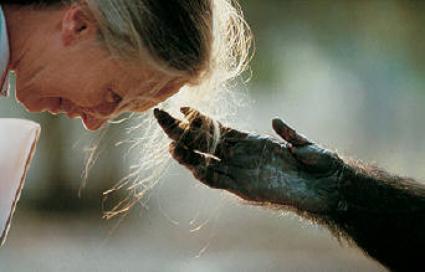
William Thomas 2018
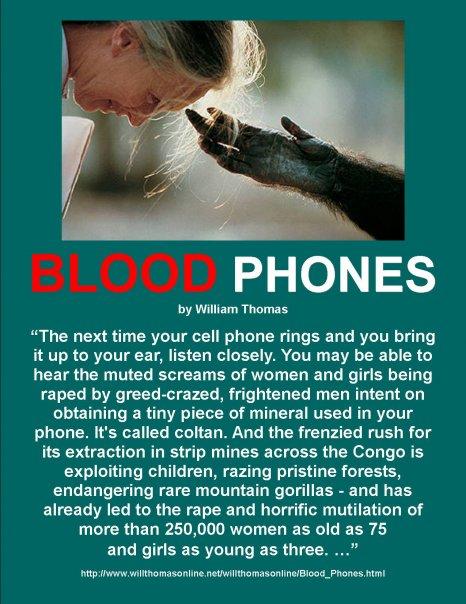

Educational and Informational Purposes: All
information on this site and all links that are linked to from
StayOnTheTruth.com represent solely the opinions of their producers.
This
information and links to more information are made available to you as a
resource for your own research and evaluation not as an endorsement.
StayOnTheTruth.com
is not in the business of persuading you or anyone else to believe
anything that that is presented linked to from this site; however, it
does encourage you to use all available resources to form your own
judgement about very important things that affect your life.
Fair Dealing and Fair Use Notice:
The material on this site is provided for educational and informational
purposes. It may contain copyrighted material the use of which has not
always been specifically authorized by the copyright owner. It is being
made available in an effort to advance the understanding of scientific,
environmental, economic, social justice and human rights issues etc. It
is believed that this constitutes a 'fair dealing' or 'fair use' of any
such copyrighted material as provided for in copyright law. In
accordance with the Fair Dealing or Fair Use intention, the material on
this site is distributed without profit to those who have an interest in
using the included information for research and educational purposes.
If you wish to use copyrighted material from this site for purposes of
your own that go beyond 'fair dealing' or 'fair use', you must obtain
permission from the copyright owner. The information on this site does
not constitute legal or technical advice.
© Copyright 2024. All Rights Reserved. "Stay On The Truth", Dianne Knight
